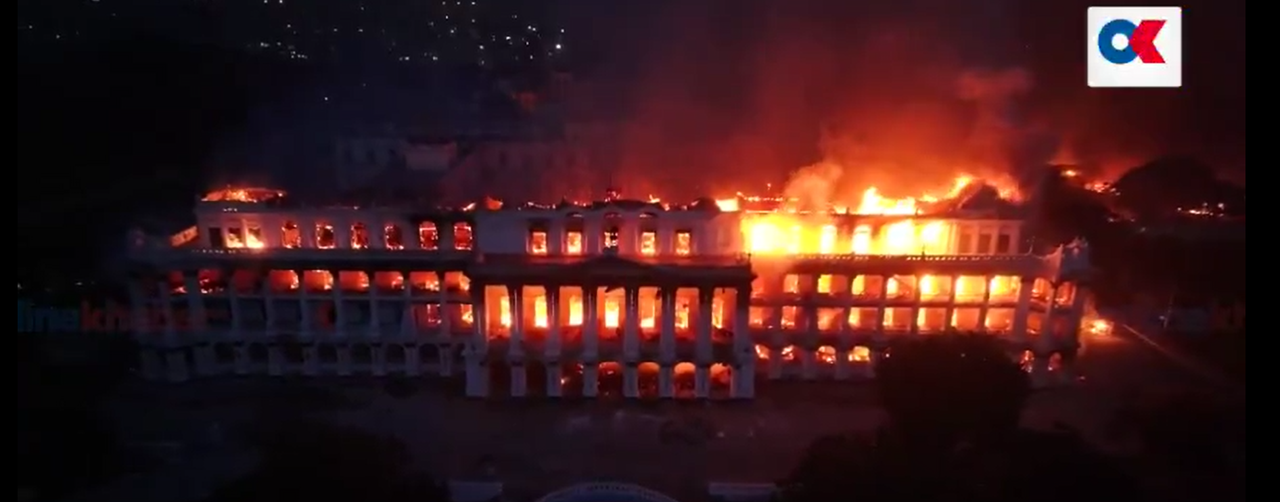Parliament in Flames: Nepal's Digital Revolution
A social media ban ignites a political firestorm in the Himalayas
Arthur Rahman
EcoBangla Correspondent
September 9, 2025
232
0

Sometimes history pivots on the smallest triggers. In Nepal, it was a social media ban that lit the fuse, but the explosion that followed revealed fault lines running much deeper than TikTok and Facebook feeds. Picture this: students flooding the streets of Kathmandu, their smartphones raised like torches against a government that dared to silence their digital voices. The images that emerged were striking – young Nepalis setting fire to effigies outside parliament, their anger burning as bright as the flames consuming cardboard politicians. What started as outrage over blocked Instagram stories and suspended Twitter accounts quickly morphed into something much more significant: the downfall of a prime minister and a potential shift in one of Asia's most complex geopolitical puzzles. The Man Who Fell K.P. Sharma Oli never looked like a man built for the digital age. The 71-year-old communist leader, with his thick-rimmed glasses and measured speeches, belonged to an era when political power flowed through party meetings and newspaper editorials, not viral videos and hashtag campaigns. His decision to ban social media platforms seemed almost quaint in its heavy-handedness – like using a sledgehammer to swat a fly. The official justification was "maintaining social harmony and preventing the spread of misinformation." The reality felt more like an aging politician's panic response to forces he couldn't control. But Oli's fall isn't just about digital rights or generational clash. It's about something far more consequential: the great game being played across South Asia, where India and China move countries like chess pieces on a Himalayan board. The Dragon's Retreat For years, China has been winning this game spectacularly. Bangladesh? Beijing's influence grew while New Delhi watched. Sri Lanka? Chinese loans built ports and bought politicians. The Maldives? Even this tiny island nation drifted into China's orbit. Nepal under Oli was perhaps Beijing's greatest prize – a landlocked buffer state that had historically been India's backyard, now hosting Chinese infrastructure projects and echoing Chinese talking points on everything from territorial disputes to trade agreements. The irony is delicious: a communist government fell because it tried to control the internet, and suddenly China's carefully cultivated influence hangs in the balance. The Communist Circus But here's where Nepal's story gets truly bizarre. This isn't a simple case of democracy versus authoritarianism, or even East versus West. Nepal's parliament hosts not one, not two, but three separate communist parties, each with its own flavor of revolutionary ideology. You have Oli's Marxist-Leninists, who just got kicked out of power. Then there are the Maoists, led by a man who goes by the official title "Comrade Prachanda" – though his friends presumably call him by his real name, Pushpa Kamal Dahal. Finally, there are the United Socialists, because apparently two communist parties weren't enough. Prachanda, the Maoist leader who is now positioned to potentially return to power, has been prime minister three times in the past 17 years. If political comebacks were an Olympic sport, he'd have a wall full of gold medals. The Indian Gamble New Delhi is watching these developments with barely contained optimism. It's been a brutal few years for Indian influence in South Asia. Every neighboring country seemed to be slipping away, drawn by Chinese investment and increasingly frustrated with India's sometimes overbearing approach to regional relationships. Nepal's student protests might represent India's first genuine opportunity for a geopolitical comeback in years. But it's a gamble built on uncertainty. Will the new government be more India-friendly? Will the Maoists, despite their ideological leanings, prove more pragmatic partners than Oli's crew? The last time pro-Indian forces held real power in Nepal was 2008 – back when the country still had a king and the political landscape looked completely different. Digital Natives, Analog Politics What makes this story fascinating is the collision between Nepal's young, digitally connected population and its deeply entrenched, often elderly political class. The students who poured into the streets aren't just angry about social media bans – they're frustrated with a political system that seems frozen in ideological debates from decades past. These protesters grew up with smartphones and social media. They're globally connected, influenced by democratic movements worldwide, and increasingly impatient with the communist rhetoric that still dominates Nepal's parliament. When their government tried to cut their digital lifelines, it wasn't just censorship – it was cultural warfare. The Complexity Trap Yet Nepal's politics resist simple narratives. This isn't a straightforward pro-democracy movement. Many of the student protesters might well vote for communist parties in future elections. The opposition that could replace Oli includes committed Marxists who have spent decades fighting against what they see as Indian hegemony. Prachanda himself embodies these contradictions. He's a Maoist who has repeatedly held power in a parliamentary system, a revolutionary who negotiates coalition governments, and a communist who might end up being more palatable to capitalist India than his Marxist-Leninist rival. What Comes Next? The parliament building's charred remains (metaphorically speaking – no actual buildings were destroyed) represent more than just student anger. They symbolize the breakdown of an old political order struggling to adapt to new realities. Nepal's students have tasted their power to change governments. They've learned that their digital voices, when amplified through street protests, can topple prime ministers. That's a lesson that will echo through future political calculations. For India and China, Nepal's political reshuffling opens new possibilities and new risks. Beijing might find its next partner more unpredictable than the steady, if uninspiring, Oli. New Delhi might discover that being preferred over China doesn't automatically translate into a reliable partnership. The Unfinished Revolution The most honest thing to say about Nepal's current moment is that nobody really knows what happens next. The country's political system is genuinely complex, its international relationships are nuanced, and its young population is increasingly unpredictable. What we do know is that a social media ban just changed the course of Himalayan geopolitics. In an age where digital rights and political freedom are becoming inseparable, that might be the most important lesson of all. The students who burned effigies outside parliament weren't just protesting internet restrictions. They were demanding a say in their country's future – digitally connected, politically engaged, and unwilling to be silenced. In Nepal's mountains, where avalanches can be triggered by the smallest disturbance, it turns out a social media ban was enough to bring down a government. The question now is what new landscape will emerge when the political snow settles.
You Might Also Like

Nr.1 Corrupted Country Russia Refutes Corruption Allegations in Bangladesh Power Project

Asia WaterWars: Bangladesh suffering worse water shortage crisis
Comments (0)
Please sign in to leave a comment
Join the conversation and share your thoughts!
No comments yet
Be the first to share your thoughts!
Popular Articles
Discover trending eco-news and popular articles from our community.
